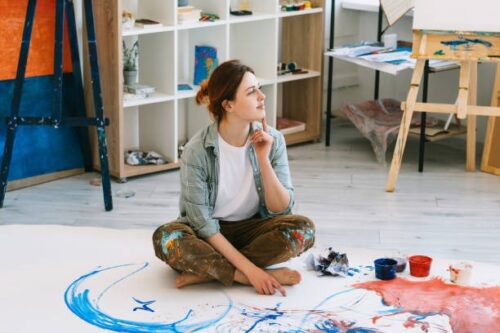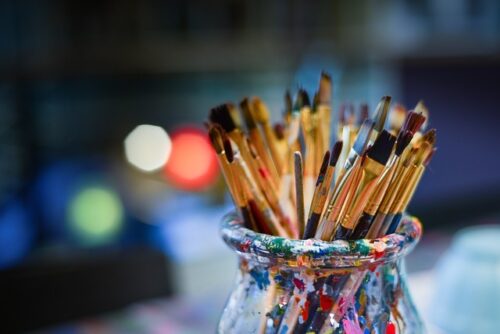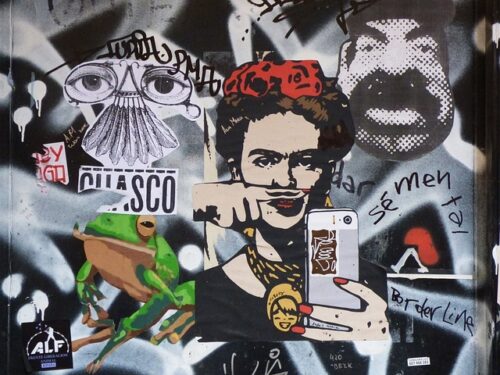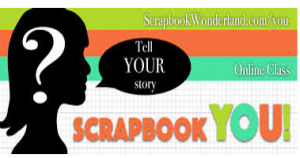Creative Therapy Techniques That Supports Mental Health

A comprehensive, holistic health treatment, expressive arts therapy techniques use artistic expression to promote physical and mental wellness. It’s a type of treatment or alternative and complementary medicine (internal medicine unit) where the patient is encouraged to use art-based exercises to solve their problems. It works particularly well for those unable to express their inner selves through words alone. Individuals can express themselves through the various creative arts mediums.
Using artistic mediums, creative therapy helps heal certain medical conditions. Individuals with a variety of psychological, emotional, and physical problems can benefit from creative therapy administered by licensed expressive arts therapists. It doesn’t require any artistic talent at all. Using artistic abilities in one’s thoughts and feelings is a component of creative therapy or expressive art therapy. These factors suggest that creative therapy administered by mental health professionals could be helpful for those who struggle with verbalizing their emotions. These can include dance movement therapy, music therapy, drama therapy, dance therapy, writing therapy and more.
Using a variety of creative mediums to express their inner selves, clients are encouraged to use creative therapy techniques. These mediums include painting, drawing, photography, clay or sculptures, music (music therapy) or theatrical performances, role-playing, poetry, dance movement, and more.
In creative therapy, several components of self awareness and expressive arts or creative arts therapies are multimodally integrated into counseling and psychotherapy. Numerous mental illnesses and psychological suffering can be treated with creative therapy. In many situations, it may be combined with other psychological methods, including cognitive-behavioral therapy (CBT) or group therapy administered by an expressive arts therapist.
An individual may benefit from a variety of creative treatment approaches. For certain mental health conditions like post traumatic stress disorder, some creative therapies could be more beneficial than others. Creative therapy has been shown to dramatically lessen the symptoms of anxiety and depression in adult survivors of trauma. Creative therapy’s effectiveness was demonstrated by how it improved the quality of life and reduced a range of psychological symptoms for patients receiving medical treatment from art therapists. In older adults, it also contributed to a decrease in depression and an improvement in self-esteem.
An individual should consult a psychotherapist, another medical expert, or an art therapist to find out which creative therapy is most beneficial for them.
Creative Therapy Techniques That Supports Mental Health
Writing
To express feelings, thoughts, events, sentiments, goals, strengths, and other types of inner experiences, creative journal writing can use words, drawings, collages, or images. When writing, you search for more expressive phrases and words that are able to convey the ideas you have in your thoughts. This aids in developing a framework that will improve your ability to articulate and convey difficult concepts more efficiently. Writing improves your ability to think and communicate. It conveys your personal identity. Additionally, it permanently and visibly changes the way you think and learn. Writing helps you get better at refining and explaining your thoughts to both yourself and other people. You are able to safely express your true voice and practice genuine self-expression by writing about your ideas and discussing your feelings.

Painting And Drawing
According to creative arts therapists, when it comes to conveying feelings, states of mind, or the dynamics of relationships that are hard to put into words, intuitive painting and drawing with pastel colors, chalk, acrylic paints, and watercolors can be helpful. Unlike any other human activity, drawing and painting allow you to connect with what you’re feeling on a very deep level. Through that process, you are able to intellectualize the feelings you are currently experiencing to a certain extent by trying to understand the reasoning behind it once you have managed to make sense of it. Furthermore, this surge might make us feel good, especially when we’re having self-esteem issues and can easily accomplish tasks that others find difficult.
Sculpting
Because clay can be molded and remolded, sculpting with it throughout an entire session can be highly therapeutic. It can be utilized to portray emotions by being stretched out, beaten, and squashed. A self-image, other individuals, and abstract thoughts and feelings can all be represented by sculpting with clay, which can withstand a lot of pressure. Since there are no precise instructions for creating art or sculptures, the emphasis is on creativity and self-expression. Additionally, it strengthens the left and right hemispheres of the brain, increases hand skills, teaches shape evaluation, and encourages improved focus and concentration. Sculpting is an excellent therapeutic technique that enhances hand-eye coordination and soothes the overactive mind.
Photography
When utilized for therapeutic context and purposes, photography is frequently referred to as phototherapy or therapeutic photography. Individuals’ appreciation of their surroundings and the things they enjoy about their everyday lives can be strengthened by phototherapy. It can also document the healing process following a loved one’s passing or trauma from unanticipated events in an international journal. Photographing includes increased creativity, consciousness, movement, and interpersonal connections. Since a single snapshot has the artistic ability to instantly transport your memories of the images, sounds, and even scents of a particular moment, it can serve as a mental lift.
Body Movement
Using movement to self-express, one is able to interact with the body’s awareness and inherent ability to heal. Dancing may or may not be a part of this. Your body can function at its best when you use your joints for high-quality physical exercise. This is because the joints are trained to support a variety of joint movements. You can keep doing activities that involve quick movement if that’s what you enjoy. Movement is incredibly beneficial to your physical health, psychological state, and overall well-being. Endorphins, sometimes called the “happy hormone,” are released more frequently during deliberate movement and exercise. You can now approach your day with an improved mental state.
Poetry
Creating art forms of poems is a key component of creative therapy, which uses symbolic meaning, expressive language, and poetry as a springboard for self-expression. Poetry enables you to enjoy the beautiful qualities of words by emphasizing the selection of words, rhythm, and connotations. In addition, the text encourages creative activity and creative thinking by using figurative language, symbolic meaning, and imagery. Knowing what’s going on in your body, mind, and heart can be aided by poetry. Poem exploration is facilitated by reading. So, poetry reading can still be mentally beneficial even if you are not a writer. It offers a distinctive method of looking at and comprehending feelings, difficulties, lifestyles, and mental health problems.

Collage
Using cutouts, pictures, paints, and felt pens, collage artists can create visually striking images. Working swiftly and impulsively while avoiding internal verbal commentary is crucial for this practice. Collages aid in the organization, development, analysis, and presentation of visual concepts that are challenging to put into words. Collage has the unique benefit of letting you arrange and reposition objects without depending on your own artistic talent. The purpose of the expressive collage-making practice is to improve self-acceptance. Making the craft with this much attention to detail and effort will improve your cognitive flexibility and help you use your brain’s capabilities better.
Role-Playing
In your life, you take on several personas in social settings, the workplace, and your personal connections. Role-playing offers real-world examples to aid in their learning. Develop real-world skills (debating, cooperation, teamwork, bargaining, and persuasion). Offer opportunities for peers to be critically observed. You are, therefore, accustomed to exploring roles and expressing challenging emotions. You can learn about the objects around you by identifying real-world circumstances through role-playing. You gain knowledge of practical skills like cooperation, teamwork, bargaining, debating, and persuading. Since role-playing offers possibilities for thoughtful evaluation of both yourself and others, it is essential to improving your mental wellness and getting rid of mental health issues.
Effectiveness Of Creative Therapy Techniques
Although there is evidence to support the potential benefits of expressive arts therapy, there are conflicting results about its efficacy. Further research is required to determine how and when creative therapy might be most helpful, as studies are frequently tiny and inconsistent. Treatments that incorporate artistic endeavors into therapy sessions are called creative and artistic therapies. A qualified expert provides help during these sessions.
Enable You To Express Ideas And Emotions That You Find Challenging To Express
Assist You In Better Understanding Yourself And Making Sense Of The World
Help You In Discussing Complex Emotions Or Challenging Situations
Offer You The Opportunity To Make Connections With Others
Provide A Secure Environment For You With A Person Who Won’t Pass Judgment
Assist You In Developing Fresh Perspectives On Issues Or Challenging Circumstances
Things To Consider
You don’t have to be artistic. People of all ages, including toddlers, teens, and adults, may benefit from creative therapy. Participation in it can be done without creative ability or exceptional talent. According to some studies, the mere existence of art might improve mental health. People frequently ask how a creative therapy session and an art lesson differ. Art therapy is mostly about allowing clients to focus on their inner experience instead of art classes, which are more concerned with teaching techniques or producing a certain final result.
People can concentrate on their thoughts, imaginations, and emotions when doing art. Instead of making art that illustrates the outside world, individuals can make art depicting their inner world. However, you must realize that only some are a good fit for creative therapy. Art therapy doesn’t require highly creative or artistic people, although many adults who think they need to be more creative or artistic may be reluctant to or doubtful of what is involved. Also, note that not every psychological problem or public health matter has been reported to respond well to creative therapy.





Recent Comments